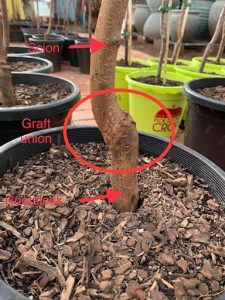Lucy McRobert on grafted fruit trees
Lucy McRobert is a horticulturalist at Nillumbik Nursery in Diamond Creek.
 Grafting combines the desirable attributes of two plants by physically splicing together the rootstock (lower half) and the scion (upper half). This allows your favourite fruits and trees to grow in conditions they would otherwise find less than ideal.
Grafting combines the desirable attributes of two plants by physically splicing together the rootstock (lower half) and the scion (upper half). This allows your favourite fruits and trees to grow in conditions they would otherwise find less than ideal.
Grafted plants are more expensive due to the additional time and expertise required to produce them.
Why grafted?
Fruit trees are almost always grafted. Here are three reasons why.
- Dwarf rootstock limits the size of the tree. This is great for those with limited space, container growing or increasing diversity of plants in an area. It can also mean less work. You probably don’t want or need to produce commercial quantities of fruit. Producing more than you can consume (or give away) is resource intensive and can leave you with wasted fruit.
- Vigour can be increased by using fast-growing rootstock, thus reducing how long we need to wait.
- Resilience and disease resistance: using rootstock that is tougher and more tolerant of local conditions creates tougher, hardier plants that may otherwise fail to thrive. Fruit trees (including citrus) are almost always grafted, but this technique is no longer limited to fruit trees and deciduous ornamentals. Although ‘native’ encompass all Australian plants, growing conditions around the country are varied and grafting makes it much easier to grow species outside their native range, like growing plants indigenous to WA in Melbourne.
How to care for grafted plants?
- Select a plant with a firm, stable, well-healed graft union (the meeting point between rootstock and scion).
- Plant at the same depth as it was in its pot. To prevent infection, don’t cover the graft with soil and mulch.
- Monitor for growth below the graft. This is growth from the rootstock, not the scion. Remove any shoots below the graft. Remember that rootstock is selected for its vigour and can take over if not monitored and maintained.
Multi-grafts … food for thought
Multi-grafted trees are those which have two or more compatible varieties grafted onto a single rootstock.
This is most commonly seen in fruit trees, for example with citrus (e.g. a lemon and a lime) or species that require cross-pollination (e.g. apples, pears or plums).
While the idea is great for those short on space, it can be tricky in practice. This is because, on multi-grafted trees, one of the scions is almost always stronger and more dominant. This means that it will grow more and grow faster than the other scions. Whilst you can control this by pruning when the tree starts to become lopsided, it will require regular pruning of the dominant graft to keep it balanced. Also, you may need to prune the dominant graft twice as often and include summer pruning to keep it manageable. If it isn’t controlled and regulated it may take over and can lead to the failure of the less dominant graft(s).
